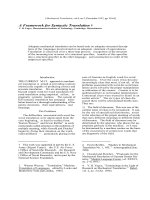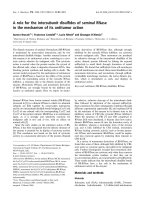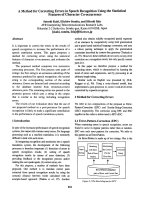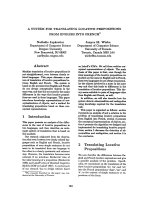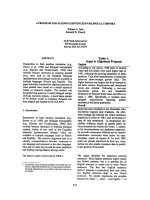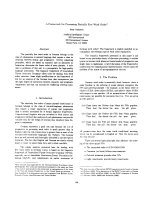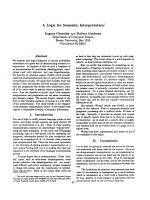Báo cáo khoa học: "A TOOL FOR THE AUTOMATIC CREATION, EXTENSION OF LEXICAL KNOWLEDGE" pdf
Bạn đang xem bản rút gọn của tài liệu. Xem và tải ngay bản đầy đủ của tài liệu tại đây (420.6 KB, 5 trang )
A TOOL FOR THE AUTOMATIC CREATION, EXTENSION AND UPDATING
OF LEXICAL
KNOWI.F.nGE BA.~F-g
Walter M.P. Daelemans
AI-LAB
Vrije Universiteit Brussels
Pleiniaan 2 Building K
B-1050
Brussels
Belgium
E-mail: walterd@arti, vub.uucp
ABSTRACT
A tool is described which helps in the creation,
extension and updating of lexical knowledge bases
(LKBs). Two levels of representation are distinguished: a
static storage level and a dynamic knowledge level. The
latter
is an object-oriented environment containing linguis-
tic and lexicographic knowledge. At the knowledge level,
constructors and filters can be defined. Constructors are
objects which extend the LKB both horizontally (new
information) and vertically (new entries) using the linguis-
tic knowledge. Filters are objects which derive new LKBs
from existing ones thereby optionally changing the storage
structure. The latter use lexicographic knowledge.
INTRODUCTION
Despite efforts in the development of tools for the
collection, sorting and editing of lexical information (see
Kipfer, 1985 for an overview), the compilation of lexical
knowledge bases (LKBs, lexical databases, machine read-
able dictionaries) is still an expensive and time-intensive
drudgery. In the worst case, a LKB has to be built up
from scratch, and even if one is available, it often does
not come up to the requirements of a particular applica-
tion. In this paper we propose an architecture for a tool
which helps both in the construction (extension and updat-
ing) of LKBs and in creating new LKBs on the basis of
existing ones. Our work falls in with recent insights about
the organisation of LKBs.
The main idea is to distinguish two representation
levels: a static
storage
/eve/ and a dynamic
knowledge
level
At the storage level, lexicai entries are represented
simply as records (with fields for spelling, phonetic tran-
scription, lexical representation, syntactic category, case
frames, frequency counts, definitions etc.) stored in text
files for easy portability. The knowledge level is an
object-oriented environment, representing linguistic and
lexicographic knowledge in a number of objects with
attached information and procedures, organised in general-
isation hierarchies. Records at the storage level are lexi-
cal objects in a 'frozen' state. When accessed from the
knowledge level, these records 'come to life' as structured
objects at some position in one or more generalisation
hierarchies (record fields ate interpreted as slot fillers).
This way, a number of procedures becomes accessible
(through inheritance) to these lexical objects.
For the creation and updating of dictio~es, coll~-
stmctors
ate defined: objects at the knowledge level which
compute new lexicai objects (corresponding to new
records at the storage level) and new information ~n~hed
to already existing lexical objects (corresponding to new
fields of existing records). To achieve this, constructor
objects mai¢ use of information already existing in the
LKB and of the linguistic kaowledge r~re~nted at the
knowledge level. Few constructors can be developed
which arc complete, i.e. which can operate fully automati-
cally without checking of the output by the user. Them-
fore, a central part in our system is a cooperative user
interface,
whose task it is to reduce initiative from the
user to a minimum.
Filters are another category
of objects. They use an
existing LKB to create automatically a new one. During
this transformation, specified fields and entries arc k~,
and others are omitted. The storage strategy used may be
changed as well. E.g. an indexed-sequential file of
phoneme representations could be derived from a diction-
ary containing this as well as oliver information, and
stored in another way (e.g. as a sequential text file). The
derived lexical knowledge base we call a daughter dict/on-
ary (DD) and the source LKB
moor dictionary (MD).
Filters use the lexicographic knowledge specified at the
knowledge level. In principle, one MD for each language
should be sufficient. It should contain as much information
as possible (see Byrd, 1983 for a similar opinion). Con-
stmctors can be developed to assist in creating, extending
and updating such an MD, thereby reducing its cost,
while LKBs for specific applications or purposes could be
derived from it by means of filters. The basic architecture
of our system is given in Figure 1.
Current and forthcoming storage and search tech-
nology (optical disks, dictionary chips) allow us to store
enormous amounts of lexical data in external memory, and
retrieve them quickly. In view of this, the traditional
storage versus computation debate (should linguistic infor-
mation be retrieved or computed?) becomes irrelevant in
the context of language technology. Natural Language
70
STORAGE LEVEL
(Mother Dictionary)
KNOWLEDGE LEVEL
CONSTRUCTORS
(Semi-automatic)
USER INTERFACE
FILTERS
(Automatic)
1
(Daughter Dictionaries)
Figure 1. A System for Creating, Extending and
Updating LKBs.
Processing systems should exhibit enough redundancy to
have it both ways. For instance, at the level of morphol-
ogy, derived and inflected forms should be stored, but at
the same time enough linguistic knowledge should be
available to compute them if necessary (e.g. for new
entries). We think the proper place for this linguistic
knowledge is the dictionary system.
There is some evidence that this redundancy is
psychologically relevant as well. The duplication of infor-
mation (co-existing rules and stored forms) could be part
of the explanation for the fuzzy results in most psycho-
linguistic experiments aimed at resolving the
concrete
versus
abstract
controversy about the organisation of the
mental lexicon (Henderson, 1985). The concrete
hypothesis states that it is possible to produce and inter-
pret word forms without resort to morphological rules
while the abstract hypothesis claims that in production and
comprehension rules are routinely used.
THE KNOWLEDGE LEVEL
We used the knowledge representation system KRS
(Steels, 1986) to implement the linguistic and lexico-
graphic knowledge. KRS can best be viewed as a glue for
connecting and integrating different formalisms (functional,
network, rules, frames, predicate logic etc.). New formal-
isms can also be defined on top of KRS. Its kernel is a
frame-based object-oriented language embedded in Lisp,
with several useful features. In KRS objects are called
concepts.
A concept has a name and a concept structure.
A concept structure is a list of subjects (slots), used to
associate declarative and procedural knowledge with a
concept. Subjects are also implemented as concepts, which
leads to a uniform representation of objects and their
associated information.
KRS has an explicit notion of meaning: each
con-
cept
has a referent (comparable to the notion of ~on)
and may have a
definition,
which is a Lisp form that can
be used to compute the referent of the concept within a
particular Lisp environment (comparable to the notion of
intcnsion).
This explicit notion of meaning makes possible
a clean interface between KRS and Lisp and between
different formalisms.
Evaluation in KRS is lazy, which means that new
objects can always be defined, but are only evaluated
when they are accessed.
Caching assures that
slot fillers
are computed only once, after which the result is stored.
The built-in
consistency
maintenance system provides the
automatic undoing of these stored results when changes
which have an effect on them are made. Different /nber/-
tance
strategies can be specified by the user.
At present, the linguistic knowledge pcrtain.q to
aspects of Dutch morphology and phonology. Our word
formation component consists of a number of morphologi-
cal rules for afftxmion and compounding. These rules
work on
lexical
representations (confining graphcmes,
phonemes, morphophoncmes, boundary symbols, stress
symbols etc.) A set of spelling rules transforms Icxical
representations
into
spelling representations, a set of pho-
nological
rules
transforms
lexical
representations into
phonetic transcriptions. We have implemented object
hierarchies and
procedures
to compute inflections, internal
word
boundaries,
morpheme boundaries syllable boun-
daries and phonetic representations (our linguistic model is
fully described in Dnelemans, 1987).
Lcxicographic knowledge consists of a number of
sorting routines and storage strategies. At present, the
definition of filters can be based on the following primi-
tive
procedures: sequential organisation, (single-key)
indexed-sequential organisation, letter tree organisation,
alphabetic sorting (taking into account the alphabetic posi-
tion of non-standard letters like phonetic symbols) and fre-
quency sorting.
Constructors can be defined using primitive pro-
cedures attached to linguistic objects. E.g. when a new
citation form of a verb is entered at the knowledge level,
constructors exist to compute the inflected forms of this
verb, the phonetic transcription, syllable and morphologi-
cal boundaries of the citation form and the inflected
forms, and of the forms derived from these
inflected
forms, and so on rccursively. Our present understandi~
of Dutch morphophonology has not yet advanced to such
7/
a level of sophistication that fully automatic extension of
this kind is possible. Therefore, the output of the con-
structors should be checked by the user. To this end, a
cooperative user interface was built. After checking by
the user, newly created or modified lexical objects can be
transformed again into 'frozen' records at the storage
level. This happens through a translation function which
transforms concepts into records. Another translation func-
tion creates a KRS object on the basis of a record.
Figure 2 shows a KRS object and its corresponding
record. This record contains the spelling, the lexical
representation, the pronunciation, the citation form (lex-
eme) and some morpho-syntactic codes of the verb form
werkte
(worked). (Records for citation forms contain
pointers to the different forms belonging to their para-
digm, and information relevant to all forms of a para-
digm: e.g. case frames and semantic information). The
corresponding concept contains exactly the same informa-
tion in its subjects, but through inheritance from concepts
like
verb-form and werken-lexeme,
a large amount of
additional information becomes accessible.
werkte
werklO@ wcrkle werken-lexeme 11210
(defoonoept werkte-form
(a
verb-form
(spelling [string "werkte'])
(lexioal-representatlon [siring "'werk#O@'])
(pronunolat|on [siring °wErkt(~'])
(lexeme werken-lexeme)
(finiteness
flnile)
(lense
pasl)
(grammatical-number singular)
(gramme tioel-person 1-2-3)))
Figure 2. A static record and its corresponding KRS
concept.
THE USER INTERFACE
We envision two categories of users of our archi-
tecture:
linguists,
who program the linguistic knowledge
and provide primitive procedures which can be used as
basic building blocks in constructors, and
lexicographers,
using predefined filters and constructors, creating new
ones on the basis of existing ones and on the basis of
primitive linguistic and lexicographic procedures, and
checking the output of the constructors before it is added
to the dictionary. The aim of the user interface is to
reduce user intervention in this checking phase to a
minimum. It fully uses the functionality of the mouse,
menu and window system of the Symbolics Lisp Machine.
When due to the incompleteness of the linguistic
knowledge new information cannot be computed with full
certainty, the system nevertheless goes ahead, using
heuristics to present an 'educated gue,s' and notifying the
user of this. These heuristics are based on linguistic
as
well as probabilistic aata A user monitoring the o~put
of the conswactor only needs to click on incorrect items
or parts of items in the output (which is mouse-semitive).
This activates diagnostic procedures associated with the
relevant linguistic objects. These procedures can delete
erroneous objects already created, recompute them or
transfer control to other objects. If the system can diag-
nose its error, a correction is presented. Otherwise, a
menu of possible corrections (again constrained by heuris-
tics) is presented from which the user may choose, or in
the worst case, the user has to enter the correct informa-
tion himself.
Consider for example the conjugation of Dutch
verbs. At some point, the citation form of an irregular
verb
(blijven,
to stay) is ~d~ to the system, and we
want to add all inflected forms (the paradigm of the verb)
to the dictionary with their pronunciation. As a first
hypothesis, the system assumes that the inflection is regu-
lax. It presents the computed forms to the user, who can
indicate erroneous forms with a simple mouse click.
Information about which and how many forms were
objected to is returned to the
diagnosis procedure associ-
ated with the object responsible for computing the regular
paradigm, which analyses this information and transfers
control to an object computing forms of verbs belonging
to a particular category of irregular verbs. Again the
forms are presented to the user. If this time no forms
are
refused, the pronunciation of each form is computed and
presented to the user for correction, and so on. This
sequence of events is illustrated in Figure 3.
Diagnostic procedures were developed for objects
involved in morphological synthesis, morphological
analysis, syllabification and phonemisation. At least for
the linguistic procedures implemented so fax a maximum
of two corrective feedbacks by the user is necessary to
compute the correct representations.
72
Indicate
false
forms
blijft
blijft
blijven
blijvend
m
ndtcate false forns
blijft,
blijft
bl ijven
blijvend
bleef
bleven
gebleven
Indlcate
I~"~I x
~ron R pronunc t at
tons
I'bLe~ftl
I'bLeH'tl
I'bLe~v~nl
I'bLe~v~ntl
I'bLefl
I'bLevanl
Iga'bLevanl
Figure 3. Corrective feedback by the user: Errone-
ous forms are indicated (top left), second (and
correct) try by the system (top right), presentation
of the pronunciations of the accepted paradigm for
checking by the user (down).
CONSTRUCTING A RHYME DICTIONARY
Automatic dictionary construction can be easily
done by using a particular filter (e.g., a citation form dic-
tionary can be filtered out from a word form dictionary).
Other more complex constructions can be achieved by
combining a particular constructor or set of constructors
with a filter. For example, to generate a word form lexi-
con on the basis of a citation form lexicon, we first have
to apply a constructor to it (morphological synthesis), and
afterwards filter the result into a suitable format. In this
section, we will describe how a
rhyme
dictionary can be
constructed on the basis of a spelling word form lexicon
in an attempt to point out how our architecture can be
applied advantageously in lexicography.
First, a constructor must be defined for the compu-
tation of a broad phonetic transcription of the spelling
forms if this information is not already present in the
MD. Otherwise, it can be simply retrieved from the MD.
Such a constructor can be defined by means of the primi-
tive linguistic procedures syllabification, phonemisation
and stress assignment The phoncmisation algorithm should
be adapted in this case by removing a number of
irrelevant phonological rules (e.g. assimilation rules).
This, too can be done interactively (each rule in the
linguistic knowledge base can be easily turned on or off
by the user). The result of applying this constructor to
the MD is the extension of each entry in it with an addi-
tional field (or slot at the knowledge level) for the tran-
scription. Next, a filter object is defined working in three
steps:
(i)
Take the broad phonetic transcription of each dic-
tionary entry and reverse it (reverse is a primitive
procedure available to the lexicographer).
(ii) Sort the reversed transcriptions first acOordin~ to
their rhyme determining part and then alphabeti-
cally. The rhyme determining part consists of the
nucleus and coda of the last stressed syllable and
the following weak syllables if any. For example,
the rhyme determining part of w~rrelea (to whirl)
is er-ve-len, of versn6llea (to accelerate) el-lea, and
of 6verwdrk (overwork) erk.
(iii) Print the spelling associated with each transcription
in the output file. The result is a spelling rhyme
dictionary. If desirable, the spelling forms can be
accompanied by their phonetic transcription.
Using the same information, we can easily develop
an alternative filter which takes into
account the metre
of
the words as well. Although two words rhyme even when
their rhythm (defined as the succession of stressed and
unstressed syllables) is different, it is common poetic
practice to look for rhyme words with the same metre.
The metre frame can be derived from the phonetic tran-
scription.
In
this variant, step (ii) must he preceded by a
step in which the (reversed)
phonetic
transcriptions are
sorted according to their metre frame.
RELATRD ~CH
The presence of both static information (morpheancs
and features) and dynamic information (morphological
rules) in LKBs is also advocated by Domenig and Shann
(1986). Their prototype includes a morphological "shell'
making possible real time word analysis when only stems
are stored. This morphological knowledge is not used,
however, to extend the dictionary and their system is
committed to a particular formalism while ours is
notation-neutral and unresuictediy extensible due to the
object-oriented implementation.
The LKB model outlined in Isoda, Also, Kami-
bayashi and Matsunaga (1986) shows some similarity to
our filter concept. Virtual dictionaries can be created using
base dictionaries
(physically
existing dictionaries) and
user-defined Association Interpreters (KIPs). The latter are
programs which
combine
primitive procedures (patmm
matching, parsing, string manipulation) to modify the
fields of the base dictionary and transfer control to other
dictionaries. This way, for example, a virtual English-
Japanese synonym dictionary can be created from
English-English and
FJlglish-Japanese base
dictionaries. In
our own approach, all information available is present in
the same MD, and filters are used to create base dic-
tionaries (physical, not virtual). Constructors are abeamt in
73
the architecture of Isoda et al. (1986).
Johnson (1985)
describes
a program computing a
reconstructed form on the basis of surface forms in
different languages by undoing regular sound changes. The
program, which is part of a system compiling a compara-
tive dictionary (semi-)automatically, may be interpreted as
related to the concept of a constructor in our own system,
with construction limited to simple string manipulations,
and not extensible unlike our own system.
CONCLUSION
We see three main advantages in our approach.
First, the distinction between a
dynamic linguistic level
with a practical user-friendly interface and a
static storage
level
allows us to construct, extend and maintain a large
MD relatively quickly, conveniently and cost-effectively
(at least for those linguistic data of which the rules are
fairly well understood). Obviously, MDs of different
languages will not contain the same information: while it
may be feasible to incorporate inflected forms of nouns,
verbs and adjectives in it for Dutch, this would not be the
case for Finnish.
Second, the linguistic knowledge necessary to build
constructor objects can be tested, optimised and experi-
mented with by continuously applying it to large amounts
of lexical material. This fact is of course more relevant to
the linguist than to the lexicographer.
Third, efficient LKBs for specific applications (e.g.
hyphenation, spelling error correction etc.) can be easily
derived from the MD due to the introduction of filters
which automatically derive DDs.
It may be the case that our approach cannot be
easily extended to the domain of syntactic and semantic
dictionary information. It is not immediately apparent how
constructors could be built e.g. for the (semi-)automatic
computation of case frames for verbs or semantic
representations for compounds. Still, a heuristics-driven
cooperative interface could be profitably used in these
areas as well.
So far, we have invested most effort into the
development of an object-oriented implementation of mor-
phological and phonological knowledge for Dutch (i.e. in
the definition of the primitive procedures which can be
used by constructors), in the development of heuristics
and diagnostic procedures, and in the design of the user
interface. A prototype of the system (written in ZetaLisp
and KRS, and running on a Symbotics Lisp Machine) has
been built. Future efforts will be directed to the extension
of the linguistic and lexicographic knowledge, the develop-
ment of a suitable script language for the definition of
constructors, and to the testing of our architecture on a
large LKB. We think of using the Topl0,000 dictionary
which is being developed at the University of Nijmegen as
a point of departure for the constm~on of a MD for
Dutch. This LKB contains some 78,000 Dutch word
forms with some morphological information.
ACKNO~
This work was financially suppoRed by the EC
(ESPRIT project 82). My research on this topic started
while I was working for the Language Technology Project
at the University of Nijmegen. I am grateful to Gerard
Kcmpen
and
Koen De SrnecR for valuable comments on
the text.
Byrd, J.R. 1983 Word Formation in Natural
Language Processing Systems. UCAI-83, Karlaruhe,
West Germany; 704-706.
Daclemans, W.M.P. 1987 S/ud/cs in
Tcc2molog7. An Object-Olqentcd Computer Model of Mor-
phophonologicM Aspects of Dutch. Doctoral DisscrtaIion,
University of Leuven.
Domcnig, M. and Shann P. 1986 Towards a Dedi-
cated Database Management System for Dictionaries.
COLING-86; 91-96.
Henderson, L. 1986 Toward a psychology of mor-
phemes. In Ellis A.W. (Ed.) Progress /n the Psycholosy
of Language~ VoL I.
London: Erlbaum.
lsoda, M., ALso, H., Kamibayashi N. and Matsu-
naga Y. 1986 Model for Lexical Knowledge Base.
COLING-86; 451-453.
Johnson,
M.
1985 Computer Aids for
Comparative
Dictionaries. L/ngu/st/cs 23, 285-302.
Kipfer, B.A. 1985 Computer Applications in Lexi-
cography
Summary of the Store-Of-The-Art. Pape.~ /n
Linguistics
18 (l); 139-184.
Steels, L. 1986 Tutorial on the KRS Concept Sys-
tem. Memo AI-LAB Brussels.
74

